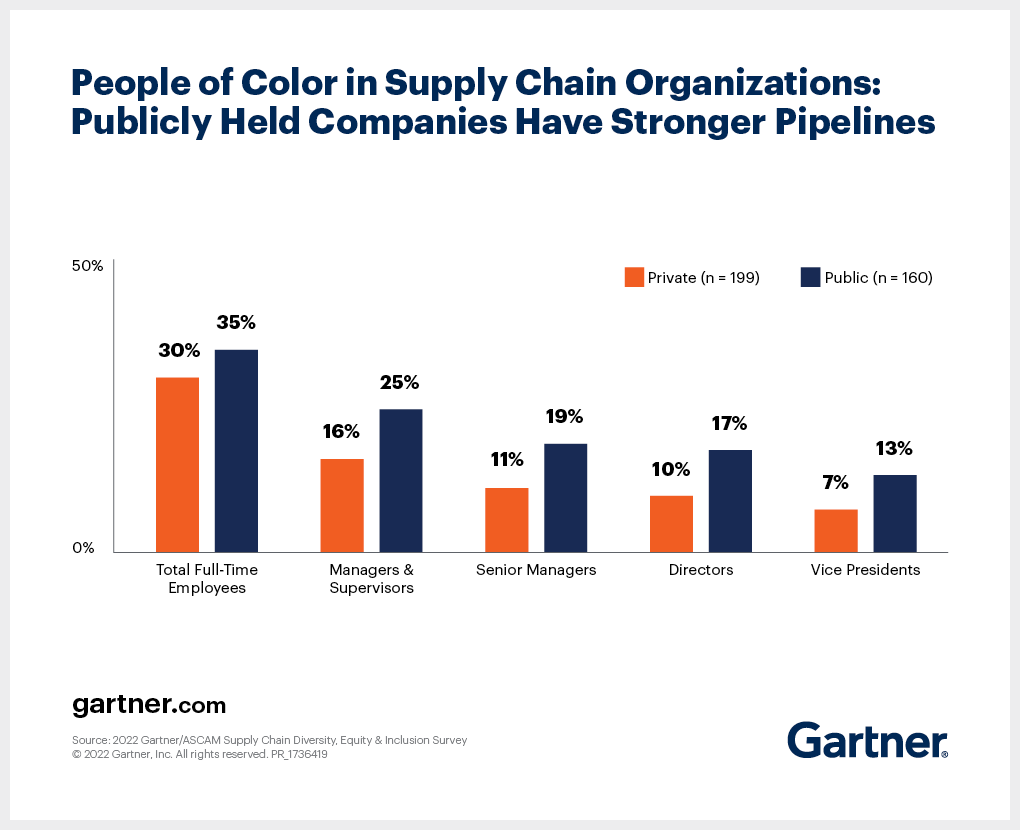May 18, 2022
- Gartner client? Log in for personalized search results.
3 Learnings for More Diversity, Equity and Inclusion in Supply Chain Organizations
Contributor: Sarah Hippold
Here’s how to successfully implement it in your organization.
In short:
- Despite the pandemic, supply chain organizations are staying committed to diversity, equity and inclusion (DEI).
- Supply chain organizations in large, publicly held companies are leading the way, and have stronger representation of people of color at all levels, compared to their smaller, privately held peers.
- Recruitment and learning and development are focus areas of DEI investments; however, inclusive leadership is key to DEI success.
The pandemic continues to cause major disruption in the workplace, but supply chain organizations nevertheless show unprecedented levels of interest in, and commitment to, diversity. The latest survey by Gartner Research and the Association for Supply Chain Management (ASCM) takes a snapshot of the state of DEI in supply chain.
“Our 2022 results find that supply chain organizations show strong intent to support diversity, equity and inclusion — particularly for women and underrepresented races and ethnicities,” says Dana Stiffler, Distinguished VP analyst at Gartner. “However, we also see a chasm between global, publicly held companies and the rest in terms of commitment and results.”
Download now: Supply Chain DEI in 2022
Supply chain leaders already have to deal with a major talent shortage. To stay attractive for new and existing talent, you must closely evaluate your organization's DEI commitments and take appropriate action. The 2022 Gartner/ASCM Supply Chain Diversity, Equity & Inclusion Survey was conducted globally, and while many of the respondents were located in the U.S., Canada and Europe, the learnings are applicable for different geographies and dimensions of diversity.
Learning No. 1: Publicly held and global companies lead the way
What jumps out immediately from the 2022 data is the difference between the largest, publicly held companies, and smaller, mostly privately held organizations when it comes to commitment and representation, but also pay equity. One obvious reason for this disparity is that public companies face more scrutiny from investors, regulators, employees, potential employees and other stakeholders. Their high stakes are visible at scale, and if they don’t keep up, potential risks and losses can be huge.
Read more: 3 Supply Chain Strategies to Drive Purpose-Driven Actions for a Fractured World
Looking at the data, we see that representation of people of color is better on all levels in supply chain organizations in publicly held companies. These companies start with a stronger base — 35% of full-time supply chain employees in publicly held organizations are people of color vs. 30% in their privately held peers. This trend continues up the career ladder and ends with 13% of vice presidents being people of color in publicly held organizations — almost twice as many as in privately held companies. We see a similar picture when we look at other factors such as pay equity.
Learning No. 2: Goals, actions and accountability are key to success
Does this mean that supply chain leaders in smaller and/or privately held companies can’t make the same progress as their public peers? Not at all. Everyone can apply the best practices that lead to DEI success in large enterprises: defining goals and actions, and creating accountability.
Read more: CSCOs Must Prepare for the Future of Supply Chain. Here’s How.
The survey found that 93% of large, global supply chain organizations have DEI goals, vs. only 37% of small organizations. Goals lead to actions, which is why those larger organizations are also 2.5 times more likely to have targeted DEI initiatives. The best organizations elevate DEI outcomes to the same priority as other business goals for individual leaders by making them a requirement to advance in the organization.
Learning No. 3: Recruiting is an investment priority, but inclusive leadership drives DEI
Once you have defined DEI goals, the next step is to determine how those goals can be achieved, and which DEI initiatives have the most impact. Recruitment, learning and development, and employee engagement are now a part of most supply chain organizations’ ambitions. Recruitment initiatives might focus on diverse interview panels or diversity referral programs; learning and development initiatives could focus on diversity mentorship programs or inclusive leader training; and employee engagement initiatives often center around employee resource groups (ERGs).
However, looking at the best-performing organizations, the survey found that the top reason for improved DEI outcomes for people of color is not an improved recruiting strategy; it’s equipping leaders to act inclusively. This means rather than teaching inclusivity as an isolated skill, leadership training must include concrete examples of how inclusive behaviors can be embedded in day-to-day leadership. Making small tweaks to processes helps nudge leaders away from unintentional biases and prompt inclusive behavior.
Gartner Supply Chain Symposium/Xpo™
Join the world's most important gathering of CSCOs, supply chain executives along with Gartner experts to transform and innovate your supply chain strategy.
Recommended resources for Gartner clients*:
*Note that some documents may not be available to all Gartner clients.
